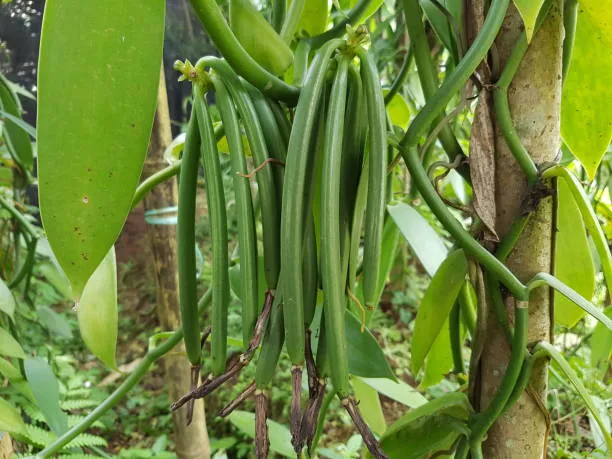Tentang Vanilla
The Intricacies of Indonesian Vanilla Exports and Their Impact on the Local Economy
Indonesia, as one of the world’s largest vanilla producers, plays a crucial role in the global vanilla market. Despite Madagascar’s dominance, producing around 80% of the world’s vanilla, Indonesia strives to enhance the quality and capacity of its production to expand its export market share. With favorable geographic conditions and abundant natural resources, the potential of Indonesian vanilla undoubtedly has significant implications for the local economy, especially for farmers and industry players.
Potential and Challenges
The Indonesian archipelago, with its humid tropical climate and ample rainfall, provides an ideal habitat for vanilla cultivation. In regions like Java, Sumatra, and Sulawesi, vanilla has become a vital commodity supporting the local economy. However, challenges also arise, particularly concerning production quality and supply consistency.
Vanilla cultivation, which requires intensive care and a long maturation period (about 3-4 years from planting to harvest), makes this commodity highly vulnerable to price fluctuations and climate change. Additionally, the quality of Indonesian vanilla is often a primary consideration for international buyers, who compare it to Madagascar’s vanilla, renowned for its distinctive aroma and flavor.
Economic Impact on Local Communities
The development of the vanilla industry not only has the potential to increase farmers’ incomes but also creates new job opportunities in production, packaging, and distribution processes. Vanilla exports bring significant foreign exchange to Indonesia, indirectly improving the quality of life for local communities.
Government programs and collaborations with international organizations in training farmers and implementing modern agricultural technologies are key to enhancing the quality of Indonesian vanilla production. With this support, farmers can produce vanilla that is not only abundant but also high-quality, meeting global market standards.
Marketing Strategies and International Cooperation
Facing global competition, Indonesia needs effective marketing strategies to elevate the Indonesian vanilla brand in the international market. Participating in international trade fairs, obtaining quality certifications, and utilizing digital promotions are some ways to increase the visibility of Indonesian vanilla.
Collaboration with major importing countries like the United States, France, and Germany is also crucial for opening new markets and stabilizing export prices. By fostering good relationships with international buyers, Indonesia can secure long-term contracts that benefit both parties.
Vanilla’s role in Indonesia’s local economy is a testament to how an agricultural commodity can significantly contribute to national economic development. With the right strategies and strong support, Indonesia can continue to strengthen its position as one of the world’s leading vanilla exporters.
For more in-depth information about the Indonesian vanilla industry and the economic potential that can be harnessed through exports, visit our website at EMAS Vanilla. Gain deeper insights and support local economic growth by learning about one of Indonesia’s finest natural treasures.
Expanding the Narrative: The Journey of Indonesian Vanilla
To further enrich the story of Indonesian vanilla, let’s delve into additional aspects that highlight its journey and impact:
Cultivation and Harvesting Techniques
Indonesian vanilla farmers often use traditional methods passed down through generations. These techniques, combined with modern agricultural practices, ensure that the vanilla beans are cultivated with care and precision. The manual pollination process, for example, requires a delicate touch and an understanding of the plant’s life cycle, ensuring that each flower is pollinated at the right time.
Post-Harvest Processing
Once harvested, the vanilla beans undergo a meticulous curing process to develop their characteristic flavor and aroma. This involves several stages, including blanching, sun-drying, and conditioning, which can take several months. The expertise of Indonesian farmers in this process is critical to producing high-quality vanilla beans that meet international standards.
Economic and Social Benefits
The vanilla industry provides not only economic benefits but also social improvements. The increased income from vanilla exports helps improve infrastructure, education, and healthcare in vanilla-growing regions. Moreover, the industry’s growth encourages the preservation of traditional farming practices and the empowerment of local communities.
Sustainability Efforts
Sustainability is a key focus for the Indonesian vanilla industry. Farmers are adopting environmentally friendly practices to ensure the long-term viability of vanilla cultivation. This includes organic farming methods, sustainable land management, and efforts to maintain biodiversity. By prioritizing sustainability, Indonesian vanilla producers can offer a product that appeals to environmentally conscious consumers around the world.
Promoting Indonesian Vanilla Globally
Efforts to promote Indonesian vanilla on the global stage include not only trade fairs and certifications but also storytelling. Sharing the rich history and cultural significance of Indonesian vanilla can captivate international audiences and create a deeper appreciation for this exquisite spice.
Final Thoughts
Indonesian vanilla is more than just a commodity; it is a symbol of cultural heritage, economic resilience, and environmental sustainability. By supporting the Indonesian vanilla industry, consumers worldwide can enjoy high-quality vanilla while contributing to the welfare of local communities and the preservation of traditional farming practices.
Explore the fascinating world of Indonesian vanilla and discover how this remarkable spice can enhance your culinary creations. Visit EMAS Vanilla to learn more and support the growth of this vital industry.

